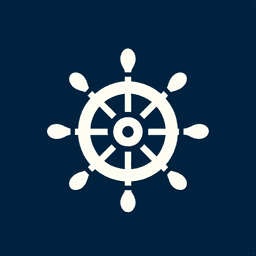
Rudder: Definition and Examples in Navigation
January 16, 2025
Rudder
A rudder is a crucial component of a ship or boat, used for steering and maneuvering. It is typically a flat piece of wood, metal, or composite material that is attached vertically to the stern (rear) of the vessel. The rudder works by redirecting the flow of water past the hull, thus changing the vessel's direction.
In maritime contexts, the rudder is controlled by a wheel or tiller, which allows the helmsman to adjust the angle of the rudder and, consequently, the course of the ship. The effectiveness of a rudder is influenced by its size, shape, and the speed of the vessel.
Historically, rudders have evolved from simple steering oars to more sophisticated designs, including balanced and semi-balanced rudders, which offer improved handling and efficiency. Modern ships may also use advanced rudder systems like the Becker rudder, which provides enhanced maneuverability.
Understanding the function and operation of a rudder is essential for sailors, as it directly impacts navigation and safety at sea. Proper maintenance and handling of the rudder are vital to ensure the vessel's responsiveness and control.
Understanding the Rudder: A Guide for Maritime Users
The rudder is a crucial component of a ship's steering system, allowing for directional control and stability. It is typically located at the stern of the vessel and works by redirecting the flow of water past the hull, thus changing the ship's direction.
How Does a Rudder Work?
A rudder operates by pivoting on a vertical axis. When the helm is turned, the rudder moves to one side, creating a pressure difference on either side of the rudder blade. This pressure difference generates a force that turns the ship in the desired direction.
Types of Rudders
There are several types of rudders used in maritime vessels, including:
- Balanced Rudder: Designed to reduce the effort needed to turn the rudder, making it easier to steer.
- Semi-Balanced Rudder: Offers a compromise between balanced and unbalanced rudders, providing moderate steering effort.
- Unbalanced Rudder: Requires more force to operate but can be more effective in certain conditions.
Maintenance of Rudders
Regular maintenance of the rudder is essential to ensure its proper functioning. This includes checking for corrosion, ensuring the rudder stock is lubricated, and inspecting the rudder blade for any damage.
Common Questions About Rudders
Maritime users often have questions about rudders, such as:
- What is the purpose of a rudder? The primary purpose of a rudder is to steer the ship by changing its direction.
- How do you maintain a rudder? Regular inspections and maintenance are crucial, including checking for wear and tear, corrosion, and ensuring proper lubrication.
- What are the signs of a failing rudder? Difficulty in steering, unusual noises, and visible damage to the rudder blade are common signs of a failing rudder.
- Why does a boat need a rudder? A rudder is essential for directional control, allowing the ship to turn and navigate effectively. Without it, the ship will still move forward due to its propulsion system, but it will drift and be subject to external forces such as wind and currents, making it difficult to control its path.
- What are the three types of rudders? Rudders are categorized as balanced, semi-balanced, or unbalanced, each offering different levels of steering effort and effectiveness.




